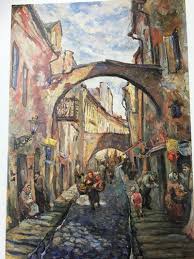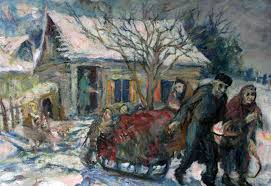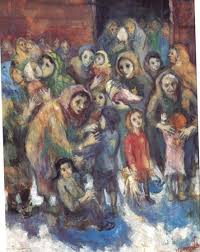David Labkovski
 David Labkovski (1906-1991) an Israeli artist. After World War Two he made aliyah to Israel and settled in Safed. In his paintings, he immortalized the annihilation of Vilna Jewry in addition to painting the residents of Safed and its landscapes. His paintings were exhibited at the David Labkovski Center for Jewish Art at the Yad Lebanim museum in Ramat Gan.
David Labkovski (1906-1991) an Israeli artist. After World War Two he made aliyah to Israel and settled in Safed. In his paintings, he immortalized the annihilation of Vilna Jewry in addition to painting the residents of Safed and its landscapes. His paintings were exhibited at the David Labkovski Center for Jewish Art at the Yad Lebanim museum in Ramat Gan.
David Labkovski was born in White Russia (Belarus today), but when he was two, the family moved to Vilna where he had a traditional Jewish education at the heder and at the Jacob Epstein high school. He studied at the College of Painting and Decorative Art until 1924. As a member of the writers and artists section Jung Vilna, he first displayed his paintings at an exhibition of Polish Jewish artists in 1922. A decade later, he sneaked into Russia and worked as a set designer in Gassat, Shlomo Mikhoels' Jewish State Theater in Moscow. He started studying at the Academy of Art in Leningrad in 1936, but a year later his studies were terminated because he was suspected of anti-Soviet activities.
In 1940 he enlisted in the Russian army and a year later was sent to Siberia where he spent the war years. When the war ended, he moved to a village near Vilna and worked as the secretary of the Jewish museum. Two years later, the museum was closed down and Labkovski went back to painting and designing posts. At the same time he began to work on the immortalization of the destroyed Vilna community.
In 1988, the David Labkovski Center for Jewish Art at the Yad Lebanim museum in Ramat Gan was established where dozens of his painting were exhibited. He died, childless, and bequeathed his home and most of his paintings to the Safed Municipality requesting that his home be turned into a museum. Unfortunately, the Safed municipality did not honor this bequest, squatters broke into his apartment and many of his paintings were destroyed.
Labkovski made aliyah in 1958 and two year later, he and his wife, Rivka, settled in Safed. Until his death, he lived in a squalid hut in Safed. Most of his family perished in the Holocaust and he committed himself to devoting the rest of his life to immortalize the memory of Jewish life that had been annihilated, through his paintings. He participated in many exhibitions, dedicating his artistic work to depicting the Jewish shtetl (town) that was annihilated as well as to the residents and landscapes of Safed and Israel.
There is a special bond between Labkovski's paintings and the stories of Shalom Aleichem; many of his paintings depict characters and literary events from Shalom Aleichem's stories. In his paintings, Jewish Vilna and the fictional village of Katrialibka are intertwined. As part of the celebrations for the centenary of Shalom Aleichem's birth, an exhibition of Labkovski's paintings was held at Bet Hahayal in Tel Aviv. It was entitled: "An exhibition by David Labkovski: Shalom Aleichem – his world, its destruction and its resurrection." In the preface to the catalog of the exhibition, Dov Sadan describes Labkovski's work thus: resurrecting the portrait of a Jewish community through the soul and eyes of one who was born there and died there, who lived there while it was still vibrant and after its destruction, came back to publicize it, to testify to the memorial (Yad Vashem) of a great Jewish city."
In an article published posthumously, one of his friends revealed that "Labkovski never sold a single painting even though there was a great demand for them. When anyone asked him why this was so, he responded that the paintings that he paints belong to the Jewish nation. They cannot belong to an individual, because they belong to one and all; they were made for one and all."
source: Wikipedia




